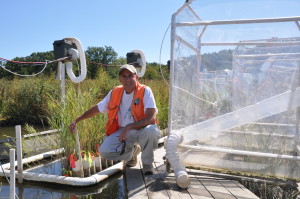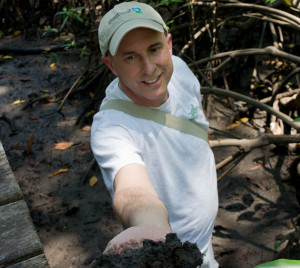by Kristen Minogue

Pat Megonigal studies the invasive reed Phragmites australis on the Smithsonian’s Global Change Research Wetland.
(Tom Mozdzer)
It’s easy to dislike Phragmites. The invasive brown reed can grow over 15 feet tall and tends to crowd out anything in its shadow. But in the story of global change, Phragmites is a gray character, like Mad Men’s Don Draper, or the enigmatic Professor Snape. Beneath the surface, Phragmites australis—a European reed sweeping over East Coast wetlands—can empower wetlands to grow higher soils and possibly survive rising seas. Biogeochemist Pat Megonigal of the Smithsonian Environmental Research Center (SERC) prefers an analogy from classic literature: Jekyll and Hyde.
“The Jekyll part is that Phragmites helps marshes maintain elevation and keep pace with sea level rise,” he said. “The Hyde part is that they are poor habitat for native plants and animals.”
The latest discovery in Megonigal’s lab could tip things in favor of Mr. Hyde. Phragmites’ deep-growing roots were once thought an advantage that helps wetlands build soil. But those same roots could be disturbing ancient soils deep underground—triggering them to release planet-warming carbon dioxide (CO2).









